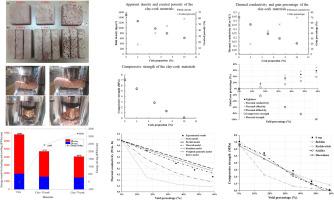Study of the design process and thermomechanical properties of a low carbon porous fired clay-cork composite for building insulation
IF 2.8
Q1 MATERIALS SCIENCE, CERAMICS
引用次数: 0
Abstract
This study develops and evaluates a fired clay–cork composite with improved thermal insulation for sustainable construction. The composite is fabricated by incorporating cork particles into clay and firing at 780 °C, generating a porous structure from cork combustion. Thermal conductivity, diffusivity, and effusivity are measured using flash and asymmetrical hot plate methods and compared to theoretical models. Mechanical performance is assessed through compressive and flexural strength tests. Results show that increasing cork content (2–10 % by mass) significantly enhances porosity (16–59 %) and reduces bulk density (1261–620 kg/m³), with thermal conductivity decreasing from 0.356 to 0.130 W/m·K. However, mechanical strength drops with higher porosity, ranging from 5.64 MPa to 0.09 MPa in compression. The Schiller and Hasselman models best describe the strength–porosity behavior. Thermal simulations demonstrate energy and environmental savings up to 37 %, with a cork content of 3.68 % identified as the structural threshold for 4 MPa compressive strength. These findings support the development of low-carbon, thermally efficient building materials using cork, an industrial by-product, and contribute to sustainable construction solutions.

建筑保温用低碳多孔烧成粘土-软木复合材料的设计工艺及热力学性能研究
本研究开发并评估了一种燃烧粘土-软木复合材料,该材料具有可持续性建筑的改进隔热性能。该复合材料是通过将软木颗粒掺入粘土并在780°C下烧制而成,由软木燃烧产生多孔结构。采用闪蒸法和非对称热板法测量了热导率、扩散率和渗透率,并与理论模型进行了比较。机械性能是通过抗压和弯曲强度测试来评估的。结果表明,增加软木含量(质量比为2 - 10%)可显著提高孔隙率(16 - 59%),降低容重(1261-620 kg/m³),导热系数从0.356降至0.130 W/m·K。然而,随着孔隙率的增加,机械强度下降,压缩强度在5.64 MPa ~ 0.09 MPa之间。Schiller和Hasselman模型最好地描述了强度-孔隙度行为。热模拟表明,当软木含量为3.68%时,可节省高达37%的能源和环境,达到4mpa抗压强度的结构阈值。这些发现支持使用软木(一种工业副产品)开发低碳、热效率高的建筑材料,并有助于可持续建筑解决方案。
本文章由计算机程序翻译,如有差异,请以英文原文为准。
求助全文
约1分钟内获得全文
求助全文
来源期刊

Open Ceramics
Materials Science-Materials Chemistry
CiteScore
4.20
自引率
0.00%
发文量
102
审稿时长
67 days
 求助内容:
求助内容: 应助结果提醒方式:
应助结果提醒方式:


